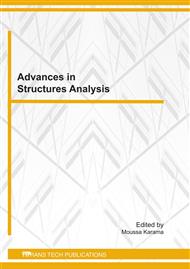[1]
W. Bangerth, H. Klie, V. Matossian, M. Parashar, and M.F. Wheeler: An Autonomic Reservoir Framework for the Stochastic Optimization of Well Placement, Cluster Computing Vol. 8 (2005), p.255–269.
DOI: 10.1007/s10586-005-4093-3
Google Scholar
[2]
H. J. C. Barbosa, A. C. C. Lemongeb, and C. C. H. Borges: A genetic algorithm encoding for cardinality constraints and automatic variable linking in structural optimization, Engineering Structures Vol. 30 (2008), pp.3708-3723.
DOI: 10.1016/j.engstruct.2008.06.014
Google Scholar
[3]
S. Bhatnagar: Adaptive Multivariate Three-Timescale Stochastic Approximation Algorithms for Simulation Based Optimization, ACM Transactions on Modelling and Computer Simulation Vol. 15 (2005), p.74–107.
DOI: 10.1145/1044322.1044326
Google Scholar
[4]
S. Bhatnagar, Michael C. Fu, Steven I. Marcus and I-J. Wang: Two-Timescale Simultaneous Perturbation Stochastic Approximation Using Deterministic Perturbation Sequences, ACM Transactions on Modelling and Computer Simulation Vol. 13 (2003).
DOI: 10.1145/858481.858486
Google Scholar
[5]
M. E. Botkin: Shape optimization of plate and shell structures, AIAA J Vol. 20 (1982), pp.268-273.
DOI: 10.2514/3.51074
Google Scholar
[6]
M. E. Botkin, and J. A. Bennett: Shape optimization of three dimensional folded plate structures, AIAA J Vol. 23 (1985), p.1804–1810.
DOI: 10.2514/3.9169
Google Scholar
[7]
C. A. Coello: Theoretical and numerical constraint-handling techniques used with evolutionary algorithms: a survey of the state of the art, Comput. Methods Appl. Mech. Engrg. Vol. 191 (2002), pp.1245-1287.
DOI: 10.1016/s0045-7825(01)00323-1
Google Scholar
[8]
X. Duan, and T. Sheppart: Shape optimization using FEA software: A V-shaped anvil as an example, Journal of Materials Processing Technology Vol. 120 (2002), pp.426-431.
DOI: 10.1016/s0924-0136(01)01200-6
Google Scholar
[9]
S. K. S. Fan, Y. C. Liang, and E. Zahara: A genetic algorithm and a particle swarm optimizer hybridized with Nelder-Mead simplex search, Computers and Industrial Engineering Vol. 50 (2006), pp.401-425.
DOI: 10.1016/j.cie.2005.01.022
Google Scholar
[10]
A. Georgieva, and I. Jordanov: Global optimization based on novel heuristics, low-discrepancy sequences and genetic algorithms, European Journal of Operational Research Vol. 196 (2009), p.413–422.
DOI: 10.1016/j.ejor.2008.03.019
Google Scholar
[11]
L. Gerencsér, G. Kozmann, and Z. Vágó: SPSA for Non-Smooth Optimization with Application in ECG Analysis, in: Proc. of IEEE Conf. on Decision and Control, IEEE, Tampa, (1998), pp.3907-3908.
DOI: 10.1109/cdc.1998.761839
Google Scholar
[12]
L. Gerencsér, G. Kozmann, Z. Vágó, and K. Haraszti: The Use of the SPSA Method in ECG Analysis, in: Proc. of IEEE Conf. of the American Control, Anchorage, AK, (2002), pp.2583-2588.
Google Scholar
[13]
W. Gong, Z. Cai, and L. Jiang: Enhancing the performance of differential evolution using orthogonal design method, Applied Mathematics and Computation Vol. 206 (2008), pp.56-69.
DOI: 10.1016/j.amc.2008.08.053
Google Scholar
[14]
L. Holzleitner, and K. G. Mahmoud: Structural shape optimization using MSC/NASTRAN and sequential quadratic programming, Comput Struct Vol. 70 (1999), pp.487-514.
DOI: 10.1016/s0045-7949(98)00179-5
Google Scholar
[15]
M. H. Imam: Three dimensional shape optimization, Int J Numer Meth Engng Vol. 18 (1982), pp.661-673.
DOI: 10.1002/nme.1620180504
Google Scholar
[16]
D.A. Johannsen, E.J. Wegman, J.L. Solka, C.E. and Priebe: Simultaneous Selection of Features and Metric for Optimal Nearest Neighbor Classification, Communications in Statistics–Theory and Methods Vol. 33 (2004), pp.2137-2157.
DOI: 10.1081/sta-200026587
Google Scholar
[17]
G. Kharmanda, A. El Hami and N. Olhoff: Global Reliability-Based Design Optimization, International Journal of Nonconvex Optimization and its Applications Vol. 74 (2003), pp.255-274.
DOI: 10.1007/978-1-4613-0251-3_14
Google Scholar
[18]
N. L. Kleinman, S.D. Hill, and V. A. Ilenda: SPSA/SIMMOD Optimization of Air Traffic Delay Cost, in: Proc. of IEEE Int. Conf. on American Control, IEEE, Albuquerque, (1997), pp.1121-1125.
DOI: 10.1109/acc.1997.609707
Google Scholar
[19]
L. Lamberti: An efficient simulated annealing algorithm for design optimization of truss structures, Computers and Structures Vol. 86 (2008), p.1936-(1953).
DOI: 10.1016/j.compstruc.2008.02.004
Google Scholar
[20]
D. C. Lee, and J. I. Lee: An integrated design for double-layered structures, Finite Elements in Analysis and Design Vol. 41 (2004), pp.133-146.
DOI: 10.1016/j.finel.2004.05.002
Google Scholar
[21]
K. S. Lee, and Z. W. Geem: A new meta-heuristic algorithm for continuous engineering optimization: harmony search theory and practice, Comput. Methods Appl. Mech. Engrg. Vol. 194 (2005), pp.3902-3933.
DOI: 10.1016/j.cma.2004.09.007
Google Scholar
[22]
D. G. Luenberger: Introduction to Linear and Nonlinear Programming, Addison Wesley, (1973).
Google Scholar
[23]
Y. Maeda: Real-Time Control and Learning Using Neuro-Controller via Simultaneous Perturbation for Flexible Arm System, ACM Transactions on Modelling and Computer Simulation Vol. 15 (2005), p.74–107.
DOI: 10.1109/acc.2002.1025174
Google Scholar
[24]
J.L. Maryak, and J.C. Spall: Simultaneous Perturbation Optimization for Efficient Image Restoration, IEEE Transactions on Aerospace and Electronic Systems Vol. 41 (2005), pp.356-361.
DOI: 10.1109/taes.2005.1413767
Google Scholar
[25]
A. Mohsine, G. Kharmanda and A. El Hami: Improved method as a robust toll for reliability based design optimization, International Journal of Structural and Multidisciplinary Optimization Vol. 32 (2006), pp.203-213.
DOI: 10.1007/s00158-006-0013-2
Google Scholar
[26]
M. Pourazady, and Z. Fu: An integrated approach to structural shape optimization, Comput. Struct. Vol. 60 (1996), pp.279-289.
Google Scholar
[27]
M. Redhe, and L. Nilsson: Optimization of the new Saab 9-3 exposed to impact load using a space mapping technique, Struct. Multidisc Optim. Vol. 27 (2004), pp.411-420.
DOI: 10.1007/s00158-004-0396-x
Google Scholar
[28]
J. C. Spall: Multivariate Stochastic Approximation using a Simultaneous Perturbation Gradient Approximation, IEEE transactions on automatic control Vol. 37 (1992), pp.332-341.
DOI: 10.1109/9.119632
Google Scholar
[29]
J. C. Spall: An Overview of the Simultaneous Perturbation Method for Efficient Optimization, Johns Hopkins APL Technical Digest Vol. 19 (1998), pp.482-492.
Google Scholar
[30]
P. Sadegh, and J.C. Spall: Optimal Random Perturbations for Stochastic Approximation Using a Simultaneous Perturbation Gradient Approximation, Proceedings of the American Control Conference (1997) Albuquerque, NM, 3582-3586.
DOI: 10.1109/acc.1997.609490
Google Scholar
[31]
W. Tang, L. Tong, and Y. Gu: Improved genetic algorithm for design optimization of truss structures with sizing, shape and topology variables, Int. J. Numer. Meth. Engng Vol. 62 (2005), pp.1737-1762.
DOI: 10.1002/nme.1244
Google Scholar
[32]
P. Tanskanen: The evolutionary structural optimization method: theoretical aspects, Comput. Methods Appl. Mech. Engrg. Vol. 191 (2002), pp.5485-5498.
DOI: 10.1016/s0045-7825(02)00464-4
Google Scholar
[33]
L. Wang, K. Chen, Y. S. Ong (Eds). Advances in Natural Computation. Part III, Springer Science & Business Publisher, Changsha, China, (2005).
Google Scholar
[34]
Z. Xinchao: A perturbed particle swarm algorithm for numerical optimization, Applied Soft Computing Vol. 10 (2010), pp.119-124.
DOI: 10.1016/j.asoc.2009.06.010
Google Scholar


